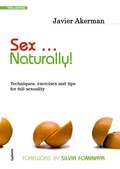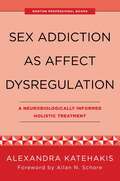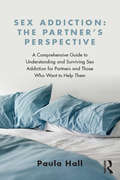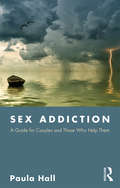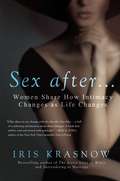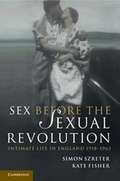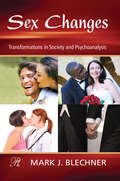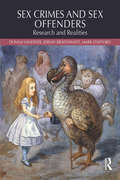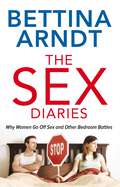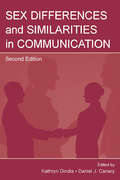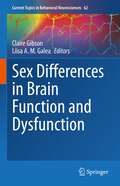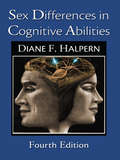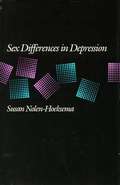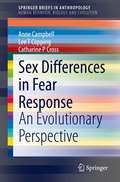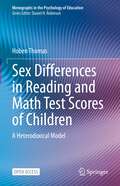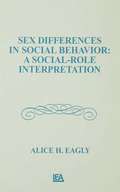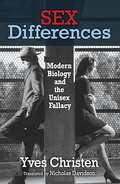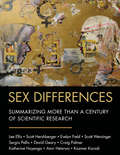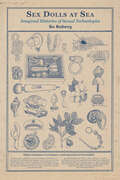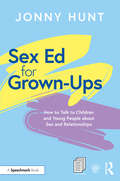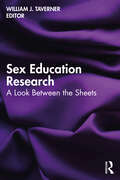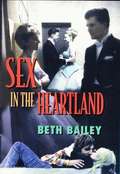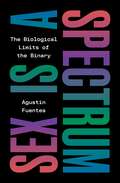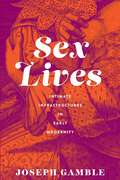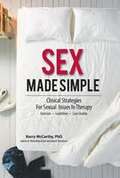- Table View
- List View
Sex ... Naturally!
by Javier AkermanIn this work, among others, you will know: How to make organic sex toys. How to get the most out of tantric sex. Kama-Sutra for Westerners. Food and meals to enhance sexual desire. Male and female masturbation techniques. Gym-sex, gymnastics to enhance sexuality. How to avoid STDs. Keys to understanding sex in all ages. “Javier Ajerman has known how to include in Sex … Naturally!” all the components that make this work a practical, entertaining manual full of advice that will delight the reader, in the literal sense of the word. It has surprised me, I assure you, at the same time that it has made me smile in many chapters, because sex and laughter are, in the author’s words “a sure path to shared happiness.” Said Silvia Fominaya on the prologue.
Sex Addiction as Affect Dysregulation: A Neurobiologically Informed Holistic Treatment (Norton Series On Interpersonal Neurobiology Ser. #0)
by Alexandra KatehakisExamining the neurobiological underpinnings of sex addiction. Neuroaffective science—studying the integrated development of the body, brain, and mind—has revealed mechanisms linking psychological and biological factors of mental disorders, including addiction. Indeed, its paradigm-shifting theoretical umbrella demonstrated that substance and behavioral dependencies share identical neurobiological workings, and thus that problematic repetitive behaviors are genuine addictions—a state increasingly understood as a chronic brain disorder. Clinical experience strongly suggests that sex addiction (SA) treatment informed by affective neuroscience—the specialty of Alexandra Katehakis—proves profoundly transformative. Katehakis's relational protocol, presented here, blends neurobiology with psychology to accomplish full recovery. Her Psychobiological Approach to Sex Addiction Treatment (PASAT) joins therapist and patient through a relationally-based psychotherapy—a holistic, dyadic dance that calls on the body, brain, and mind of both. Written with clarity and compassion, this book integrates cutting-edge research, case studies, verbatim session records, and patient writings and art. Katehakis explicates neurophysiological, psychological, and cultural forces priming and maintaining SA, then details how her innovative treatment restores patients' interpersonal, sexual, and spiritual relationality.
Sex Addiction: A Comprehensive Guide to Understanding and Surviving Sex Addiction For Partners and Those Who Want to Help Them
by Paula HallSex and pornography addiction are growing problems that devastate the lives of partners as well as sufferers. Sex Addiction: The Partner's Perspective has been written to help partners and those who care about them to survive the shock of discovering their partner is a sex addict and to help them make decisions about the future of their relationships and their lives. First and foremost, it is a practical book, full of facts, and self help exercises to give partners a much needed sense of stability and control. Like its sister book, Understanding and Treating Sex Addiction, it includes case examples and survey results revealing the reality of life for partners of sex addicts. Sex Addiction: The Partner's Perspective is divided into three parts. Part I explores the myths surrounding sex addiction and provides up to date information about what sex addiction is and what causes it before moving on to explain why the discovery hurts partners so much. Part II is about partners’ needs and includes self-help exercises and strategies to help partners regain stability, rebuild self-esteem and consider their future. The controversial topic of co-dependency is also explored with guidance on how to identify it, avoid it and overcome it. Part III focuses on the couple relationship starting with the difficult decision of whether to stay or leave. Whatever the decision, partners will then find help and support for rebuilding trust and reclaiming their sexuality. This book has been written to help partners not only survive, but to grow stronger and move on with their lives – whether alone, or in their relationship. Readers will find revealing statistics and real life stories shared by partners who kindly took part in the first UK survey of sex addiction partners. This book will this book be a valuable guide for partners, but also for the therapists who seek to support them on their journey of recovery.
Sex Addiction: A Guide for Couples and Those Who Help Them
by Paula HallSex Addiction: A Guide for Couples and Those Who Help Them is a practical book that provides empathic support, guidance, information and pragmatic strategies for couples who want to survive sex and porn addiction - whether that’s together, or apart. Sex and porn addiction devastates couple relationships, and unlike the impact of infidelity, there is no ‘before’ to get back to and no ‘after’. This book adopts the metaphor of a boat, presenting addiction as the tidal wave that devastates the relation-ship, leaving both crew members fighting for survival. There’s guidance to ensure each partner makes it safely back to shore and advice on surveying the damage to your relation-ship and deciding if you want to save it and set sail again. You’ll find practical advice for both the partner and the addicted partner, including first-hand accounts of couples that have already undertaken the journey. There are exercises to do alone, and many to share together, to help you understand what’s happened, consider your future, and if you choose to stay together, begin the task of rebuilding trust and intimacy. Sex Addiction is not only a practical guide for couples, but also for the therapists who support them. This book will be a companion to Paula Hall’s previous books on sex addiction and builds on the already known frameworks and models used, but it is also written to stand alone.
Sex After . . .
by Iris KrasnowThe bestselling author of The Secret Lives of Wives offers a refreshingly straightforward guide to enjoying a long, satisfying sex life. Women of the baby boomer generation know and trust Iris Krasnow as a writer who speaks candidly to the issues that concern them most. In the months following the publication of her most recent book, The Secret Lives of Wives, Krasnow addressed thousands of women, and she discovered that two subjects dominated her audiences' conversations: sex and change. Whether women are worried about marriage and divorce or illness and death, they're all asking: "How do I handle the shifts in my sexuality caused by these events?" Sex After . . . holds the answers to everything from regaining sexual confidence after childbirth and breast cancer to navigating the dating scene in senior communities. As with all of Krasnow's books since her New York Times bestseller Surrendering to Marriage, the narrative is driven by real women's stories: raw, intimate, and, most importantly, true. Prescriptive, emancipating, and insightful, Sex After . . . addresses a range of circumstances, including what happens:When you or your spouse doesn't want sex anymoreAfter cancer, amputation, PTSD, or another illness maims the bodyIf you come out of the closet at middle ageWhen your marriage is damaged by adulteryIf you're dating again after twenty-five years with the same sexual partnerWhen your husband is addicted to Viagra Filled with edgy and honest stories of carnal challenge and triumph from women of all backgrounds and life stages, Sex After . . . is Krasnow's signature take on Everything You Ever Wanted to Know About Sex but Were Afraid to Ask--during all of life's passages. Krasnow is a media and lecture tour favorite, and readers--whether in the heat of an initial can't-eat-can't-sleep attraction or rounding the corner to their sixtieth anniversary--will applaud her eye-opening perspectives on the one issue that can change lives for better or worse like nothing else.ike nothing else.
Sex Before the Sexual Revolution: Intimate Life In England, 1918-1963
by Simon Szreter Kate FisherWhat did sex mean for ordinary people before the sexual revolution of the 1960s and 1970s, who were often pitied by later generations as repressed, unfulfilled and full of moral anxiety? This book provides the first rounded, first-hand account of sexuality in marriage in the early and mid-twentieth century. These award-winning authors look beyond conventions of silence among the respectable majority to challenge stereotypes of ignorance and inhibition. Based on vivid, compelling and frank testimonies from a socially and geographically diverse range of individuals, the book explores a spectrum of sexual experiences, from learning about sex and sexual practices in courtship, to attitudes to the body, marital ideals and birth control. It demonstrates that while the era's emphasis on silence and strict moral codes could for some be a source of inhibition and dissatisfaction, for many the culture of privacy and innocence was central to fulfilling and pleasurable intimate lives.
Sex Changes: Transformations in Society and Psychoanalysis (Psychoanalysis in a New Key Book Series)
by Mark J. BlechnerThe last half-century has seen enormous changes in society’s attitude toward sexuality. In the 1950s, homosexuals in the United States were routinely arrested; today, homosexual activity between consenting adults is legal in every state, with same-sex marriage legal in Massachusetts and Connecticut. In the 1950s, ambitious women were often seen as psychopathological and were told by psychoanalysts that they had penis envy that needed treatment; today, a woman has campaigned for President of the United States. Mark Blechner has lived and worked through these startling changes in society, and Sex Changes collects papers he has written over the last 45 years on sex, gender, and sexuality. Interspersed with these papers are reflections on the changes that have occurred during that time period, both within the scope of society at large as well as in his personal experiences inside and outside of the therapeutic setting. He shows how changes in society, changes in his life, and changes in his writing on sexuality - as well as changes within psychoanalysis itself - have affected one another. One hundred years ago, psychoanalysis was at the cutting edge of new ideas about sex and gender, but in the latter half of the 20th Century, psychoanalysts were often seen as reactionary upholders of society’s prejudices. Sex Changes seeks to restore the place of psychoanalysis as the "once and future queer science," and aims for a radical shift in psychoanalytic thinking about sexuality, gender, normalcy, prejudice, and the relationship of therapeutic aims and values.
Sex Crimes and Sex Offenders: Research and Realities
by Donna Vandiver Jeremy Braithwaite Mark Stafford<p>Sex Crimes and Sex Offenders: Research and Realities provides an overview of social scientific theory and research on sex crimes and sex offenders. Most other books on the market are focused on a single issue—such as treatment, rape, pedophilia, theory, etc. This book is unique in that it covers the most current theory and research along with individual cases of sex crimes (e.g., Kobe Bryant, Jerry Sandusky, and other case studies), effectively linking theory and research with the realities of sex crimes and sex offenders as well as their victims. <p>Vandiver, Braithwaite, and Stafford are careful to dispel myths and to focus on the heterogeneity of sex crimes and sex offenders, and not on any one issue or population or theory. Instead, they weave a framework using a full range of theoretical concepts and research data to integrate their discussions of crimes, offenders, victims, treatments, and policy implications. The result is a valuable resource for students and early-stage researchers investigating sex crimes or offenders.</p>
Sex Diaries: Why Women Go Off Sex And Other Bedroom Battles
by Bettina ArndtIn The Sex Diaries Australia's best known sex therapist, Bettina Arndt, uncovers the night-time drama being played out in bedrooms everywhere—the creeping hand and feigning of sleep, the staying up late in the hope that he will doze off. It is one of the great inconvenient truths of relationships that after the first blissful years together, most men want more sex than their female partners. Bettina Arndt recruited ninety-eight couples to keep diaries, revealing their intimate negotiations over sex. Who feels like having sex? Who doesn't? And how do couples cope if one person wants it more than the other? She draws on her thirty-five years of professional experience to provide a provocative analysis that challenges our basic assumptions about sex. With her characteristic humour and insight, Bettina Arndt proposes a new approach to how couples can enjoy regular sex—and sustain loving relationships.
Sex Differences and Similarities in Communication (Routledge Communication Series)
by Daniel J. Canary Kathryn DindiaSex Differences and Similarities in Communication offers a thorough exploration of sex differences in how men and women communicate, set within the context of sex similarities, offering a balanced examination of the topic. The contents of this distinctive volume frame the conversation regarding the extent to which sex differences are found in social behavior, and emphasize different theoretical perspectives on the topic. Chapter contributors examine how sex differences and similarities can be seen in various verbal and nonverbal communicative behaviors across contexts, and focus on communication behavior in romantic relationships. The work included here represents recent research on the topic across various disciplines, including communication, social psychology, sociology, linguistics, and organizational behavior, by scholars well-known for their work in this area. In this second edition, some chapters present new perspectives on sex/gender and communication; others present substantially revised versions of earlier chapters. All chapters have a stronger theoretical orientation and are based on a wider range of empirical data than those in the first edition. Readers in communication, social psychology, relationships, and related fields will find much of interest in this second edition. The volume will serve as a text for students in advanced coursework as well as a reference for practitioners interested in research-based conclusions regarding sex differences in communicative behavior.
Sex Differences in Brain Function and Dysfunction (Current Topics in Behavioral Neurosciences #62)
by Claire Gibson Liisa A. M. GaleaDoes sex matter when it comes to brain function? This volume attempts to answer this very important question which is of relevance to the disciplines of psychology, neuroscience, psychiatry and neurology. Understanding how brain function and resultant behaviors may differ between the sexes impacts upon our knowledge of the pathology and development of treatments for various neurological and psychiatric disorders, particularly those that show significant sex differences in either prevalence and/or manifestation of symptoms. This volume covers three main themes of research into sex differences in basic neurobiology, psychology, preclinical research and clinical research. It begins by exploring our understanding of sex and gender in relation to both animal and human behaviors and discusses the relevance, and importance, of considering sex and gender when conducting research into brain function and behaviors. The second theme focuses on how sex and gender influence mental health and considers the impact of our immune system and the changes that occur with ageing. Finally, the third aspect focuses on examples of neurological disorder which show sex differences in terms of their aetiology and/or symptomology and considers the relevance in the development of treatment for these disorders including dementia, stroke and multiple sclerosis. This volume is of considerable interest to mental health and neurology professionals, including psychiatrists, neurologists, nurses, allied health clinicians and pharmacists. It is also helpful and important for preclinical researchers working in neuroscience, psychopharmacology and reproductive endocrinology.
Sex Differences in Cognitive Abilities (4th Edition): 4th Edition
by Diane F. HalpernThe fourth edition of Sex Differences in Cognitive Abilities critically examines the breadth of research on this complex and controversial topic, with the principal aim of helping the reader to understand where sex differences are found – and where they are not. Since the publication of the third edition, there have been many exciting and illuminating developments in our understanding of cognitive sex differences. Modern neuroscience has transformed our understanding of the mind and behavior in general, but particularly the way we think about cognitive sex differences. But neuroscience is still in its infancy and has often been misused to justify sex role stereotypes. There has also been the publication of many exaggerated and unreplicated claims regarding cognitive sex differences. Consequently, throughout the book there is recognition of the critical importance of good research; an amiable skepticism of the nature and strength of evidence behind any claim of sex difference; an appreciation of the complexity of the questions about cognitive sex differences; and the ability to see multiple sides of an issues, while also realizing that some claims are well-reasoned and supported by data and others are politicized pseudoscience. The author endeavors to present and interpret all the relevant data fairly, and in the process reveals how there are strong data for many different views. The book explores sex differences from many angles and in many settings, including the effect of different abilities and levels of education on sex differences, pre-existing beliefs or stereotypes, culture, and hormones. Sex differences in the brain are explored along with the stern caveat to "mind the gap" between brain structures and behaviors. Readers should come away with a new understanding of the way nature and nurture work together to make us unique individuals while also creating similarities and differences that are often (but not always) tied to our being female and male. Sex Differences in Cognitive Abilities, Fourth Edition, can be used as a textbook or reference in a range of courses and will inspire the next generation of researchers. Halpern engages readers in the big societal questions that are inherent in the controversial topic of whether, when , and how much males and females differ psychologically. It should be required reading for parents, teachers, and policy makers who want to know about the ways in which males and females are different and similar.
Sex Differences in Depression
by Susan Nolen-HoeksemaHow can we account for the fact that women are twice as likely as men to experience protracted sadness, apathy, low self-esteem and other symptoms of depression?
Sex Differences in Fear Response: An Evolutionary Perspective (SpringerBriefs in Anthropology)
by Anne Campbell Lee T Copping Catharine P CrossThis book reviews the evolutionary forces behind sex differences in fear responses and, crucially, delves into the mechanisms through which sexual selection might have driven sex differences in connection with fear. Fear is an evolved mechanism that helps us stay alive, but is also an emotion experienced more intensely, more frequently, and longer in women than in men. This book therefore asks the following question: Why might evolution have made women more motivated than men to avoid danger? It provides an overview of the brain areas underpinning the experience of fear and evaluates the evidence that these areas manifest sex-specific differences in their structure and function. Given its scope, the book will be essential reading for anyone interested in an evolutionary perspective on psychological sex differences.
Sex Differences in Reading and Math Test Scores of Children: A Heterodoxical Model (Monographs in the Psychology of Education)
by Hoben ThomasThis open access book examines why reading and math test scores for boys and girls have differed since the origins of testing in the United States. It details the pattern of differences that have remained largely unchanged for more than 100 years in the United States and worldwide. The book explores why boys have modestly larger math test score means than girls, and why girls have far larger reading test score means than boys. Boys have larger test score variances for both tasks. The only data of focus—and thus the only data to be explained—are boys’ and girls’ test score sample means and variances. In addition, the book provides the only coherent theory of gender differences explaining math and reading test score means and variances obtained in observational settings. It develops the simple genetical idea framed within a finite probability mixture model; it provides parameter estimates and displays numerous estimated probability distributions associated with the selected accessible studies chosen for analysis; and it extends the theory and provides explanations for never understood puzzling features of test score data. The book requires no auxiliary sources, although some understanding of random variables and probability theory is required to follow the formalization. It contains all technical details, including the estimation procedure and an R code implementation. Key areas of coverage include: · Extensive literature summary from a unique data inequalities perspective. · Perspective that challenges existing viewpoints on sex differences, falsifying conventional perspectives. · Illustrates probability modeling of psychological data. · Illustrates the failure of conventional statistics to explain data and the need for modeling data. Sex Differences in Reading and Math Test Scores of Children is an invaluable resource for researchers, professors, and graduate students in educational psychology, teaching and teacher education, literacy / language teaching and learning, mathematics education, curriculum studies, developmental psychology, statistics, and all interrelated disciplines.
Sex Differences in Social Behavior: A Social-role interpretation (Distinguished Lecture Series #Vol. 1985)
by Alice H. EaglyIn presenting an innovative theory of sex differences in the social context, this volume applies social-role theory and meta-analytic techniques to research in aggression, social influence, helping, nonverbal, and group behavior. Eagly's findings show that gender stereotypic behavior results from different male and female role expectations, and that the disparity between these gender stereotypes and actual sex differences is not as great as is often believed.
Sex Differences: Modern Biology and the Unisex Fallacy (Research And Perspectives In Endocrine Interactions Ser.)
by Yves Christen Nicholas DavidsonFew people realize how much science can tell us about the differences between men and women. Yves Christen, provided the first comprehensive overview of research in this area when this classic book was first published in the1990s. He goes beyond simplistic biology is destiny arguments and constructs a convincing case for linking social and biological approaches in order to understand complex differences in behavior.Biologists agree that the sexes differ in brain and body structure. Christen links these differences in cerebral anatomy to differences in behavior and intellect. Taking his readers on a journey through psychology, endocrinology, demography, and many other fields, Christen shows that the biological and the social are not antagonistic. To the contrary, social factors tend to exaggerate the biological rather than neutralize it.This controversial work, Sex Differences, takes on traditional feminism for its refusal to confront the evidence on biologically determined sex differences. Christen argues for a feminism that sees traits common to women in a positive light, in the tradition of such early feminists as Clemence Royer and Margaret Sanger, as well as more contemporary feminist sociobiologists like Sarah Hrdy. We deny sex differences only at the price of scientific truth and our own self-respect.
Sex Differences: Summarizing More than a Century of Scientific Research
by Sergio Pellis David Geary Lee Ellis Amir Hetsroni Scott Hershberger Evelyn Field Scott Wersinger Craig Palmer Katherine Hoyenga Kazmer KaradiThis volume is the first to aim at summarizing all of the scientific literature published so far regarding male-female differences and similarities, not only in behavior, but also in basic biology, physiology, health, perceptions, emotions, and attitudes. Results from over 18,000 studies have been condensed into more than 1,900 tables, with each table pertaining to a specific possible sex difference. Even research pertaining to how men and women are perceived (stereotyped) as being different is covered. Throughout this book's eleven years in preparation, no exclusions were made in terms of subject areas, cultures, time periods, or even species. The book is accompanied by downloadable resources containing all 18,000+ references cited in the book.Sex Differences is a monumental resource for any researcher, student, or professional who requires an assessment of the weight of evidence that currently exists regarding any sex difference of interest. It is also suitable as a text in graduate courses pertaining to gender or human sexuality.
Sex Dolls at Sea: Imagined Histories of Sexual Technologies (Media Origins)
by Bo RubergInvestigating and reimagining the origin story of the sex doll through the tale of the sailor&’s dames de voyage.The sex doll and its high-tech counterpart the sex robot have gone mainstream, as both the object of consumer desire and the subject of academic study. But sex dolls, and sexual technology in general, are nothing new. Sex dolls have been around for centuries. In Sex Dolls at Sea, Bo Ruberg explores the origin story of the sex doll, investigating its cultural implications and considering who has been marginalized and who has been privileged in the narrative. Ruberg examines the generally accepted story that the first sex dolls were dames de voyage, rudimentary figures made of cloth and leather scraps by European sailors on long, lonely ocean voyages in centuries past. In search of supporting evidence for the lonesome sailor sex doll theory, Ruberg uncovers the real history of the sex doll. The earliest commercial sex dolls were not the dames de voyage but the femmes en caoutchouc: &“women&” made of inflatable vulcanized rubber, beginning in the late nineteenth century. Interrogating the sailor sex doll origin story, Ruberg finds beneath the surface a web of issues relating to gender, sexuality, race, and colonialism. What has been lost in the history of the sex doll and other sex tech, Ruberg tells us, are the stories of the sex workers, women, queer people, and people of color whose lives have been bound up with these technologies.
Sex Ed for Grown-Ups: How to Talk to Children and Young People about Sex and Relationships
by Jonny HuntWhen it comes to talking to children and young people about sex and relationships, it is difficult to know what to say. How do you answer their questions? How much is too much? And what is age appropriate? Sex Ed for Grown-Ups is an open and honest guide that empowers adults to talk to young people about all things sex and relationships. Written by an independent relationships and sex education consultant, this light-hearted and accessible book encourages grown-ups to think and talk about the topics that scare them the most: from body parts, gender, puberty and first-time sex, to pornography, sexting and knowing what to do when things go wrong. Full of hints, tips and first-hand stories, it is a fun, compassionate and engaging exploration of relationships and sex, which will help adults to fully support young people as they develop a healthy view of both sex and themselves. Sex Ed for Grown-Ups is essential reading for parents, teachers, youth workers, social workers and any adult who wants to have well-informed and positive conversations with the children and young people in their lives.
Sex Education Research: A Look Between the Sheets
by William J. TavernerCurated by the chief editor of the American Journal of Sexuality Education, this book presents engaging and accessible chapters that capture current and essential research findings from leaders in the sexuality education field. William J. Taverner brings together an impressive array of contributors to help sexuality professionals remain up-to-date on the most relevant issues in sex education today. Covering a spectrum of hot sexuality education topics, including abstinence, gender, innovative programs, pleasure, the politics of sexuality education, porn literacy, sexual orientation, and more, each chapter describes key findings on a particular topic, their significance, their practical application, and how these new developments have arrived. The book includes chapters that address individuals across all age ranges, from children to older adults, as well as sexuality education and training programs for specialized professions, such as nurses and school-based health occupations. Practical and clear, this book identifies priorities and trends in the field, addresses marginalized audiences and overlooked topics, and hopes to encourage important discussions to come. Sex Education Research: A Look Between the Sheets provides a wide range of occupations and academic disciplines with a foundation of research essential to their work, such as public health professionals and students of human sexuality, gender studies, biology, psychology, sociology, as well as community educators, school nurses and health teachers, and administrative leaders affiliated with sexuality education programs at community-based organizations.
Sex In the Heartland
by Beth BaileySex in the Heartland is the story of the sexual revolution in a small university town in the quintessential heartland state of Kansas. Bypassing the oft-told tales of radicals and revolutionaries on either coast, Beth Bailey argues that the revolution was forged in towns and cities alike, as "ordinary" people struggled over the boundaries of public and private sexual behavior in postwar America.
Sex Is a Spectrum: The Biological Limits of the Binary
by Agustín FuentesWhy human biology is far more expansive than the simple categories of female and maleBeing human entails an astonishingly complex interplay of biology and culture, and while there are important differences between women and men, there is a lot more variation and overlap than we may realize. Sex Is a Spectrum offers a bold new paradigm for understanding the biology of sex, drawing on the latest science to explain why the binary view of the sexes is fundamentally flawed—and why having XX or XY chromosomes isn&’t as conclusive as some would have us believe.In this lively and provocative book, leading biological anthropologist Agustín Fuentes begins by tracing the origin and evolution of sex, describing the many ways in the animal kingdom of being female, male, or both. Turning to humans, he presents compelling evidence from the fossil and archaeological record that attests to the diversity of our ancestors&’ sexual bonds, gender roles, and family and community structures, and shows how the same holds true in the lived experiences of people today. Fuentes tackles hot-button debates around sports and medicine, explaining why we can acknowledge that females and males are not the same while also embracing a biocultural reality where none of us fits neatly into only one of two categories.Bringing clarity and reason to a contentious issue, Sex Is a Spectrum shares a scientist&’s perspective on why a binary view of sex and gender is not only misguided but harmful, and why there are multitudes of ways of being human.
Sex Lives: Intimate Infrastructures in Early Modernity
by Joseph GambleIn Sex Lives, Joseph Gamble draws from literature, art, and personal testimonies from sixteenth- and seventeenth-century Europe to uncover how early moderns learned to have sex. In the early modern period, Gamble contends, everyone from pornographers to Shakespeare recognized that sex requires knowledge of both logistics (how to do it) and affect (how to feel about it). And knowledge, of course, takes practice.Gamble turns to a wide range of early modern texts and images from England, France, and Italy, ranging from personal accounts to closet dramas to visual art in order to excavate and analyze a variety of sexual practices in early modernity. Using an intersectional, phenomenological approach to bring historical light to the quotidian sexual experiences of early modern subjects, the book develops the critical concept of the “sex life”—a colloquialism that opens up methodological avenues for understanding daily lived experience in granular detail, both in the distant past and today. Through this lens, Gamble explores how sex organized and permeated everyday life and experiences of gender and race in early modernity. He shows how affects around sex structure the plays of Shakespeare and his contemporaries, revealing the role of sexual feeling and sexual racism in early modern English drama.Sex Lives reshapes how we understand Renaissance literature, the history of sexuality, and the meaning of sex in both early modern Europe and our own moment.
Sex Made Simple: Clinical Strategies for Sexual issues in Therapy
by Barry McCarthyStrategies to move past affairs, sexual trauma, variant arousal, Framework for counseling gay individuals and couples, Treating sexual dysfunction, Psycho sexual skill exercises, Case Studies, Psycho bio social model for assessment, treatment, and relapse prevention.
